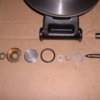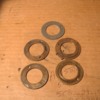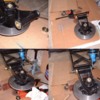quote:
* was solid bronze the original? any preferance between types for rebuild?
Yes- OEM bushings were solid thin-wall, lightly pressed in. Bushing removal is difficult mostly because they are thin and there's no withdrawal notch nor step in the back. Some guys VERY carefully split the bushings with a broken hacksaw blade or a cape-chisel & hammer; then they come out fairly easily. The angular range of motion of the a-arms back & forth in the bushings is quite small so if you replace them, I'd go for a hard bronze and definitely modify the system for external grease-ability.
One Pantera owner changed to needle bearings ala Jaguar, then found (just like Jag) the needles stay so close to the same place when driving, they flatten from loads over time. In this case a bushing works better and is simpler & cheaper. Can't really improve on the system except in detail.
* Is there any negative to having the volume in the upright filled with grease?
I assume you mean the 'lower' cavity where the stud and spacer resides. Some misguided people also add a zerk to the wheel bearing cavity up above, not realizing the wheel bearings are sealed units! And that open area takes many pounds of grease besides, almost of which simply sits there.
No problem with filling the stud/space cavity that I've found. Note in the exploded parts photo above, the dents from the locating dowels in some of the bronze washers when they slipped out of position during a reassembly attempt. The 40+-year-old rubber o-rings in the end-caps need to compress to seal rainwater or car-wash water out, and this makes getting things back correctly a chore sometimes. We just aren't strong enough to force it all back together without clamps, levers and other help, then the washers slip and you can't really tell!




